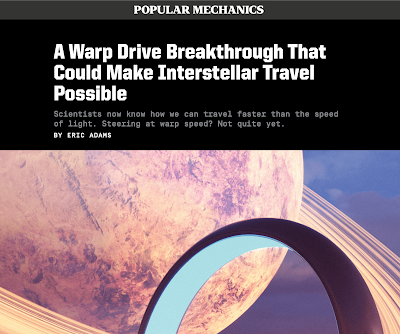The August/September edition of Popular Mechanics magazine (I always think that is such a wonderfully Victorian-sounding magazine) carried the blaring A Warp Drive Breakthrough That Could Make Interstellar Travel Possible. Eyebrow raising in itself, though the tagline beneath was arguably worse in saying 'Scientists now know how we can travel faster than the speed of light.'
Let's unpack those. First to note is that weasel word 'Could' in the title. When this is deployed, it's often a flag that what follows is pure speculation. But the tagline doesn't say that scientists 'may now know', it's absolutely straight - apparently they do know how we can travel faster than light - let's do it!
The basis for this assertion was something that Harold 'Sonny' White did in 2020, and builds on work that goes back to the 1990s, when physicist Miguel Alcubierre first came up with a hypothetical approach to produce a spacetime warp effect. By 2012, White had become involved and suggested some ways to make the concept slightly less hypothetical. (Notice all those proviso words.) So why is this suddenly news? It's not obvious why something done in 2020 is suddenly exciting, but let's check out the claim.
Back in 2020, after White noticed an anomaly when working with the Casimir effect - the mechanism for generating a kind of negative energy on an extremely tiny scale - a phenomenon that would be needed on a vast scale for a warp drive - he did a mathematical exploration of what had happened and deduced that if a sphere on the micron scale (a micron is a millionth of a metre) were in this environment, it should generate a tiny 'warp bubble' around it. Ooh!
To be fair to Eric Adams, the author of the piece, he does get a proviso in paragraph 5 - distinctly early for this kind of article: 'To emphasize: White didn’t actually make a warp bubble. But the data from his study led to an aha moment: For the first time, a buildable warp bubble showed promise of success.' This almost always happens with speculative science writing - there is a warning at some point, though often they come near the end.
The reality is that even if it were possible to produce a warp bubble on this scale inside a pair of Casimir plates, it has zero practical applicability. It can't be scaled up, because the Casimir effect only occurs on extremely small scales. And, for that matter, having a full-sized functioning bubble would only be a small part of building a working warp drive. The real thing would require vast amounts of energy, and would need some way (which no one has ever devised) of preventing it from being deadly. Unlike in science fiction, where warp drive ships disappear from one location and appear in another, a ship using an Alcubierre drive would be warping its way through space. Anything in its way, even a speck of dust, would cause a disastrous collision. For that matter, navigation, bearing in mind anything inside a hypothetical warp bubble can't see anything outside it, would be impossible.
According to Adams 'Warp technology's core science is surprisingly sound. Though the specific mechanics of an actual device haven’t been fully unpacked, the math points toward feasibility.' I'm sorry, the maths does no such thing. This is just fantasy. It is sound in the sense that the physics of producing a warp bubble on the micron scale is conceptually viable, if not necessarily achievable. But there is zero feasibility for a real warp drive ship.
This all fun, but the reality is that scientists do not know how we can travel faster than the speed of light. I wish they did. I love science fiction, but I'm a realist. SF writers have always been allowed a few fantasy elements to make their stories work, and FTL travel is one of them. That's fine in fiction, but not in science. Adams ends his piece saying 'So, despite all the advances, the horizon for a warp drive remains achingly remote.' This is more than a bit different from the headline, though even the ending underplays the unlikeliness of this ever being a reality.
It's unfair to necessarily blame the science writers - in many cases, they're being paid to deliver a story in the format that the magazine or newspaper demands, and they've a living to make. As long as they put those qualifiers in, they can feel reasonably justified in what they are doing. But I do wish we could move away from such super-speculative stories, which do nothing for the public understanding of science, and instead give the impression that we are capable of far more than we truly are. It is all too possible that this kind of material gives ammunition to science deniers, who can say 'Look, the scientists keep promising far more than they deliver' - and that's not a good thing.
Feature by Brian Clegg - See all Brian's online articles or subscribe to a weekly email free here


Comments
Post a Comment